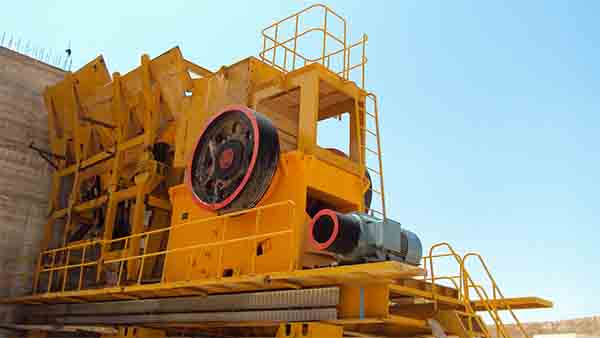The Difference of Different Types of Jaw Crusher
As a widely used rough crushing equipment, the jaw crusher has a history of over 100 years. The current jaw crusher has certain differences in structure, shape, design, material, and so on. This article mainly introduces the crushing cavity, the frame, the adjustment of the discharge port, the installation of the motor, and the bearing.
1. Crushing chamber
The traditional crushing cavity is a “right triangle”, the fixed jaw is a straight side, and the movable jaw is a hypotenuse. The new crushing chamber is a “symmetric isosceles triangle”. In the case of the same feed opening size, the allowable feed particle size is 5% larger than that of the traditional crushing cavity type.
The angle between the movable jaw and the fixed jaw of the jaw crusher is the main parameter to measure the performance of the crusher. The smaller the included angle, the greater the crushing force. The advanced angle is between 18°-21°, and the angle of domestic traditional PE crusher is between 21°-24°. The crusher with a small included angle has high requirements on the manufacture and processing of the body, shaft, bearing, etc. due to the large crushing force it bears.
2. Frame
Jaw crusher frame has welding frame body, bolt connection frame body, open frame body, and the box frame body. Metso’s C series jaw crusher adopts an open bolt connection frame, which has the advantage of being detachable for transportation, strong adaptability to underground works, and convenient for frame repair. The disadvantage is that the assembly requirements are high, and the installation accuracy should not be guaranteed. Sandvik’s CJ series jaw crusher adopts a box-type cast steel welded frame, which has high strength, good structural stability, and high manufacturing precision. The disadvantage is that the rack body must be transported as a whole.
3. Mine outlet adjustment mechanism
The jaw crusher discharge opening adjustment mechanism includes “gasket” adjustment and “wedge block” adjustment. The “shim” is convenient and reliable to adjust, and easy to manufacture. “Wedge block” adjustment operation is convenient, but the reliability is not as good as the “shim” type. In recent years, a “hydraulic cylinder” has been developed to replace the toggle plate and the adjustment mechanism of the discharge port. This kind of crusher has obvious advantages in mobile crushing stations.
4. Motor installation type
There are two ways to install the motor:
A.The motor is placed on the crusher frame (integrated), and the V-belt drive is adopted. The crusher is generally elastically connected with the foundation by rubber gaskets.
B.Install the motor on the foundation (independent), at this time, the crusher needs to be connected with the foundation bolt.
5. Types of bearings and housings
Bearing is the core component of jaw crushers, generally, choose double row tapered roller spherical bearing. Frame bearing housing, you can choose integral bearing housing or semi-open bearing housing.
6. Start and control
The main motor of the jaw crusher can generally be started directly, electronic soft starter, and varistor start.
A.Direct start is generally aimed at small jaw crushers with low motor power.
B.The varistor start is suitable for wound motors. Due to the large blocking torque of the winding motor, it is more suitable for the working conditions of the crusher.
7.Crusher speed and stroke
Compared with the rotation speed and stroke of domestic PE jaw crusher, the products of major international jaw crusher manufacturers have larger rotation speed and stroke.
Related Products
There are no relevant articles.



